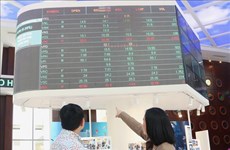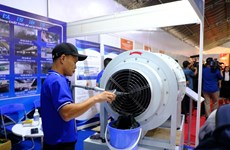Domestic production takes time to fully recover: experts
Experts expect Vietnam to achieve 2013 GDP growth between 5.3–5.4
percent while keeping annual inflation to 6.2–6.3 percent but warn
domestic production needs more time to make a complete recovery,
according to Radio the Voice of Vietnam (VOV)
Experts expect Vietnam to achieve 2013 GDP growth between 5.3–5.4
percent while keeping annual inflation to 6.2–6.3 percent but warn
domestic production needs more time to make a complete recovery,
according to Radio the Voice of Vietnam (VOV)
Macroeconomic results
ASEAN Statistics recently lauded Vietnam’s measures against inflation, acknowledging that although it remains among the region’s highest, the Government is obviously intent on reining in.
The Vietnam General Statistics Office reported the consumer price index (CPI) rose 0.34 percent in November, pushing the 11-month CPI increase to 5.5 percent. Industrial production is gradually recovering, with its index improving 5.7 percent in November and 5.6 percent in the 11-month period.
A recent World Bank report presented 2013 as Vietnam’s third consecutive year of steady macroeconomic advances. The bank said the government’s 2011–2012 measures helped Vietnam reduce inflation, readjust its fiscal balance, and preserve currency market stability.
At a September 2013 meeting with Prime Minister Nguyen Tan Dung in Washington DC, International Monetary Fund Managing Director Christine Lagarde praised Vietnam’s macroeconomic stability and urged the country to continue the economic restructuring ambitions designed to better its current 5 percent GDP growth rate.
A government report revealed 11-month export earnings increased 15 percent to nearly 120 billion USD; imports rose 15.9 percent to 120 billion USD; registered foreign direct investment (FDI) exceeded 20 billion USD, a 14 percent leap; and disbursed FDI grew 6 percent to 10.55 billion USD.
Vietnam attracted 4.6 billion USD in official development assistance (ODA) capital during the reviewed period, a year-on-year rise of 14.1 percent. Disbursed ODA also improved 13.5 percent to 4.04 billion USD.
The number of newly registered businesses reflected these positive trends with another 9.3 percent rise and more than 12,600 businesses emerged from stagnation to resume operations.
Greater efforts
Domestic and foreign experts warn Vietnamese economic growth is not as secure as it appears and faces significant threats. Expert Nguyen Dinh Anh believes the limits of the current growth model, based on public investments, low labour cost, and natural resources exploitation, will strangle any potential for national economic breakthroughs if it is extended into 2014.
ASEAN Statistics highlight the Vietnamese prices of essential services and commodities are almost all higher than regional averages, particularly in medicine and medical services, entertainment, and tourism. It recommends striving for a firmer handle on inflation and better economic performance to achieve sustainable growth.
The FDI sector is still the country’s major economic contributor, leaving the domestic and private sectors dwindling in its wake. During the past 11 months, the FDI sector recorded an export surplus of 12.2 billion USD compared to the 12.3 billion USD trade deficit burdening the domestic business sector.
FDI is also a major driver of industrial production. The processing and manufacturing industries attracted 16.1 billion USD in FDI during the 11 months, 77 percent of Vietnam’s total registered FDI capital.
The government insists business restructuring is a crucial step towards reviving the domestic economy. Dr Nguyen Minh Phong says successfully facilitating private business operations could propel national economic development.-VNA
Macroeconomic results
ASEAN Statistics recently lauded Vietnam’s measures against inflation, acknowledging that although it remains among the region’s highest, the Government is obviously intent on reining in.
The Vietnam General Statistics Office reported the consumer price index (CPI) rose 0.34 percent in November, pushing the 11-month CPI increase to 5.5 percent. Industrial production is gradually recovering, with its index improving 5.7 percent in November and 5.6 percent in the 11-month period.
A recent World Bank report presented 2013 as Vietnam’s third consecutive year of steady macroeconomic advances. The bank said the government’s 2011–2012 measures helped Vietnam reduce inflation, readjust its fiscal balance, and preserve currency market stability.
At a September 2013 meeting with Prime Minister Nguyen Tan Dung in Washington DC, International Monetary Fund Managing Director Christine Lagarde praised Vietnam’s macroeconomic stability and urged the country to continue the economic restructuring ambitions designed to better its current 5 percent GDP growth rate.
A government report revealed 11-month export earnings increased 15 percent to nearly 120 billion USD; imports rose 15.9 percent to 120 billion USD; registered foreign direct investment (FDI) exceeded 20 billion USD, a 14 percent leap; and disbursed FDI grew 6 percent to 10.55 billion USD.
Vietnam attracted 4.6 billion USD in official development assistance (ODA) capital during the reviewed period, a year-on-year rise of 14.1 percent. Disbursed ODA also improved 13.5 percent to 4.04 billion USD.
The number of newly registered businesses reflected these positive trends with another 9.3 percent rise and more than 12,600 businesses emerged from stagnation to resume operations.
Greater efforts
Domestic and foreign experts warn Vietnamese economic growth is not as secure as it appears and faces significant threats. Expert Nguyen Dinh Anh believes the limits of the current growth model, based on public investments, low labour cost, and natural resources exploitation, will strangle any potential for national economic breakthroughs if it is extended into 2014.
ASEAN Statistics highlight the Vietnamese prices of essential services and commodities are almost all higher than regional averages, particularly in medicine and medical services, entertainment, and tourism. It recommends striving for a firmer handle on inflation and better economic performance to achieve sustainable growth.
The FDI sector is still the country’s major economic contributor, leaving the domestic and private sectors dwindling in its wake. During the past 11 months, the FDI sector recorded an export surplus of 12.2 billion USD compared to the 12.3 billion USD trade deficit burdening the domestic business sector.
FDI is also a major driver of industrial production. The processing and manufacturing industries attracted 16.1 billion USD in FDI during the 11 months, 77 percent of Vietnam’s total registered FDI capital.
The government insists business restructuring is a crucial step towards reviving the domestic economy. Dr Nguyen Minh Phong says successfully facilitating private business operations could propel national economic development.-VNA













